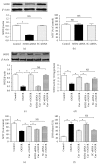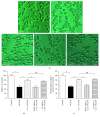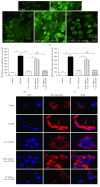SOD2 Mediates Curcumin-Induced Protection against Oxygen-Glucose Deprivation/Reoxygenation Injury in HT22 Cells
- PMID: 31662771
- PMCID: PMC6791267
- DOI: 10.1155/2019/2160642
SOD2 Mediates Curcumin-Induced Protection against Oxygen-Glucose Deprivation/Reoxygenation Injury in HT22 Cells
Abstract
Curcumin (Cur) induces neuroprotection against brain ischemic injury; however, the mechanism is still obscure. The aim of this study is to explore the potential neuroprotective mechanism of curcumin against oxygen-glucose deprivation/reoxygenation (OGD/R) injury in HT22 cells and investigate whether type-2 superoxide dismutase (SOD2) is involved in the curcumin-induced protection. In the present study, HT22 neuronal cells were treated with 3 h OGD plus 24 h reoxygenation to mimic ischemia/reperfusion injury. Compared with the normal cultured control group, OGD/R treatment reduced cell viability and SOD2 expression, decreased mitochondrial membrane potential (MMP) and mitochondrial complex I activity, damaged cell morphology, and increased lactic dehydrogenase (LDH) release, cell apoptosis, intracellular reactive oxygen species (ROS), and mitochondrial superoxide (P < 0.05). Meanwhile, coadministration of 100 ng/ml curcumin reduced the cell injury and apoptosis, inhibited intracellular ROS and mitochondrial superoxide accumulation, and ameliorated intracellular SOD2, cell morphology, MMP, and mitochondrial complex I activity. Downregulating the SOD2 expression by using siRNA, however, significantly reversed the curcumin-induced cytoprotection (P < 0.05). These findings indicated that curcumin induces protection against OGD/R injury in HT22 cells, and SOD2 protein may mediate the protection.
Copyright © 2019 Yuqing Wang et al.
Conflict of interest statement
The authors declare no conflicts of interest.
Figures







Similar articles
-
Curcumin Alleviates β Amyloid-Induced Neurotoxicity in HT22 Cells via Upregulating SOD2.J Mol Neurosci. 2019 Apr;67(4):540-549. doi: 10.1007/s12031-019-01267-2. Epub 2019 Feb 12. J Mol Neurosci. 2019. PMID: 30746607
-
Curcumin protects neurons against oxygen-glucose deprivation/reoxygenation-induced injury through activation of peroxisome proliferator-activated receptor-γ function.J Neurosci Res. 2014 Nov;92(11):1549-59. doi: 10.1002/jnr.23438. Epub 2014 Jun 26. J Neurosci Res. 2014. PMID: 24975470
-
Ginsenosides Rb1 and Rg1 Protect Primary Cultured Astrocytes against Oxygen-Glucose Deprivation/Reoxygenation-Induced Injury via Improving Mitochondrial Function.Int J Mol Sci. 2019 Dec 3;20(23):6086. doi: 10.3390/ijms20236086. Int J Mol Sci. 2019. PMID: 31816825 Free PMC article.
-
Natural compound methyl protodioscin protects rat brain from ischemia/reperfusion injury through regulation of Mul1/SOD2 pathway.Eur J Pharmacol. 2019 Apr 15;849:50-58. doi: 10.1016/j.ejphar.2019.01.057. Epub 2019 Feb 1. Eur J Pharmacol. 2019. PMID: 30716316
-
[Mitophagy mediated by ligustilide relieves OGD/R-induced injury in HT22 cells].Zhongguo Zhong Yao Za Zhi. 2022 Apr;47(7):1897-1903. doi: 10.19540/j.cnki.cjcmm.20211029.404. Zhongguo Zhong Yao Za Zhi. 2022. PMID: 35534260 Chinese.
Cited by
-
Curcumin Efficacy in a Serum/Glucose Deprivation-Induced Neuronal PC12 Injury Model.Curr Mol Pharmacol. 2021;14(6):1146-1155. doi: 10.2174/1874467214666210203211312. Curr Mol Pharmacol. 2021. PMID: 33538682 Free PMC article.
-
Mitochondrial DNA and Neurodegeneration: Any Role for Dietary Antioxidants?Antioxidants (Basel). 2020 Aug 17;9(8):764. doi: 10.3390/antiox9080764. Antioxidants (Basel). 2020. PMID: 32824558 Free PMC article. Review.
-
Mechanisms Underlying Curcumin-Induced Neuroprotection in Cerebral Ischemia.Front Pharmacol. 2022 Apr 26;13:893118. doi: 10.3389/fphar.2022.893118. eCollection 2022. Front Pharmacol. 2022. PMID: 35559238 Free PMC article. Review.
-
Protective effects of silibinin on LPS-induced inflammation in human periodontal ligament cells.Front Chem. 2022 Oct 10;10:1019663. doi: 10.3389/fchem.2022.1019663. eCollection 2022. Front Chem. 2022. PMID: 36300030 Free PMC article.
-
Polyphenols for the Treatment of Ischemic Stroke: New Applications and Insights.Molecules. 2022 Jun 29;27(13):4181. doi: 10.3390/molecules27134181. Molecules. 2022. PMID: 35807426 Free PMC article. Review.
References
-
- Anderson C. S., Huang Y., Lindley R. I., et al. Intensive blood pressure reduction with intravenous thrombolysis therapy for acute ischaemic stroke (ENCHANTED): an international, randomised, open-label, blinded-endpoint, phase 3 trial. Lancet. 2019;393(10174):877–888. doi: 10.1016/S0140-6736(19)30038-8. - DOI - PubMed
-
- Murakami K., Suzuki M., Suzuki N., Hamajo K., Tsukamoto T., Shimojo M. Cerebroprotective effects of TAK-937, a novel cannabinoid receptor agonist, in permanent and thrombotic focal cerebral ischemia in rats: therapeutic time window, combination with t-PA and efficacy in aged rats. Brain Research. 2013;1526:84–93. doi: 10.1016/j.brainres.2013.06.014. - DOI - PubMed
LinkOut - more resources
Full Text Sources

